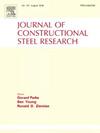Seismic response analysis of cable-stiffened latticed shells with buckling-restrained braces
IF 4
2区 工程技术
Q1 CONSTRUCTION & BUILDING TECHNOLOGY
引用次数: 0
Abstract
The dynamic response of large-span structures, such as cable-stiffened latticed shells, under seismic action is significant. This study introduces steel buckling-restrained braces (BRBs) into cable-stiffened latticed shell structures and uses small-scale shaking table experiments and finite element analysis to thoroughly investigate their impact on vibration damping performance. The accuracy of the numerical simulation methods in predicting the natural frequencies and dynamic responses of cable-stiffened latticed shells was validated by comparing the results of small-scale shaking table tests with finite element simulations. Based on the deformation characteristics of different natural modes of a cable-stiffened latticed shell, four innovative BRB arrangement methods were designed, and their vibration damping performances under three types of seismic waves were analysed. The results demonstrate that the method proposed in this study, which optimizes the BRB arrangement based on natural mode characteristics, can significantly control the displacement response of cable-stiffened latticed shell structures under seismic loads. The M2 arrangement exhibits an optimal damping effect under various seismic intensity conditions.
求助全文
约1分钟内获得全文
求助全文
来源期刊

Journal of Constructional Steel Research
工程技术-工程:土木
CiteScore
7.90
自引率
19.50%
发文量
550
审稿时长
46 days
期刊介绍:
The Journal of Constructional Steel Research provides an international forum for the presentation and discussion of the latest developments in structural steel research and their applications. It is aimed not only at researchers but also at those likely to be most affected by research results, i.e. designers and fabricators. Original papers of a high standard dealing with all aspects of steel research including theoretical and experimental research on elements, assemblages, connection and material properties are considered for publication.
 求助内容:
求助内容: 应助结果提醒方式:
应助结果提醒方式:


